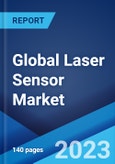A laser sensor is an electrical device used for sensing the precise location of objects. It is a self-contained, pinpoint laser emitter that produces light in a straight line, which is reflected into the receiver for contactless measurement. Some commonly available laser sensors include charge-coupled devices (CCD), complementary metal-oxide semiconductor (CMOS), photoelectric sensors and positive sensitive detectors. Laser sensors offer various benefits, including high reliability, accuracy, sensitivity and control with minimal deviation. They are used for stamping, engraving and various manufacturing applications, such as laser manufacturing, 3D imaging and sensing, material processing and micromachining. They also find extensive application for material height and thickness measurement, weld gap detection, train and railroad inspection and crane positioning.
Laser Sensor Market Trends
The increasing requirement for automation across industries, such as manufacturing, aviation, construction and automotive, is one of the key factors driving the growth of the market. Laser sensors are widely used for manufacturing plant automation and management, security, surveillance and motion and guidance. Moreover, the widespread adoption of miniaturized sensors is providing a thrust to the market growth. For instance, laser sensors are installed in the Light Detection and Ranging (LIDAR) systems of automobiles for the detection of objects and mapping the distances. Additionally, various technological advancements, such as the integration of laser sensors with the Industrial Internet of Things (IIoT) and artificial intelligence (AI) solutions, are acting as other growth-inducing factors. These innovative sensors are widely used in the food and beverage industry for screening assembly lines and maintaining consistent food standards of processed food products. Other factors, including the increasing adoption of smart manufacturing practices, along with rapid industrialization, especially in the developing economies, are anticipated to drive the market toward growth.Key Market Segmentation
This research provides an analysis of the key trends in each sub-segment of the global laser sensor market report, along with forecasts at the global, regional and country level from 2023-2028. The report has categorized the market based on type, component, application and end user.Breakup by Type:
- Compact
- Ultra-Compact
Breakup by Component:
- Hardware and Software
- Services
Breakup by Application:
- Security and Surveillance
- Motion and Guidance
- Process Monitoring and Quality Control
- Distance Measurement
- Manufacturing Plant Management
Breakup by End User:
- Automotive
- Aerospace and Defense
- Food and Beverages
- Consumer Electronics
- Chemical
- Healthcare
Breakup by Region:
- North America
- United States
- Canada
- Asia-Pacific
- China
- Japan
- India
- South Korea
- Australia
- Indonesia
- Europe
- Germany
- France
- United Kingdom
- Italy
- Spain
- Russia
- Latin America
- Brazil
- Mexico
- Middle East and Africa
Competitive Landscape
The competitive landscape of the industry has also been examined along with the profiles of the key players being Baumer Electric AG, First Sensor AG (TE Connectivity Ltd.), IFM Electronic GmbH, Keyence Corporation, Laser Technology Inc., Micro-Epsilon Messtechnik GmbH & Co. KG, MTI Instruments Inc. (Mechanical Technology Incorporated), OMRON Corporation, Optex Co. Ltd., Panasonic Corporation, Rockwell Automation Inc., Schmitt Industries Inc and SmartRay GmbH.Key Questions Answered in This Report:
- How has the global laser sensor market performed so far and how will it perform in the coming years?
- What has been the impact of COVID-19 on the global laser sensor market?
- What are the key regional markets?
- What is the breakup of the market based on the type?
- What is the breakup of the market based on the component?
- What is the breakup of the market based on the application?
- What is the breakup of the market based on the end user?
- What are the various stages in the value chain of the industry?
- What are the key driving factors and challenges in the industry?
- What is the structure of the global laser sensor market and who are the key players?
- What is the degree of competition in the industry?
Table of Contents
Companies Mentioned
- Baumer Electric AG
- First Sensor AG (TE Connectivity Ltd.)
- IFM Electronic GmbH
- Keyence Corporation
- Laser Technology Inc.
- Micro-Epsilon Messtechnik GmbH & Co. KG
- MTI Instruments Inc. (Mechanical Technology Incorporated)
- OMRON Corporation
- Optex Co. Ltd.
- Panasonic Corporation
- Rockwell Automation Inc.
- Schmitt Industries Inc
- SmartRay GmbH
Methodology

LOADING...
Table Information
| Report Attribute | Details |
|---|---|
| No. of Pages | 140 |
| Published | November 2023 |
| Forecast Period | 2022 - 2028 |
| Estimated Market Value ( USD | $ 663 Million |
| Forecasted Market Value ( USD | $ 1197.2 Million |
| Compound Annual Growth Rate | 10.4% |
| Regions Covered | Global |
| No. of Companies Mentioned | 13 |









